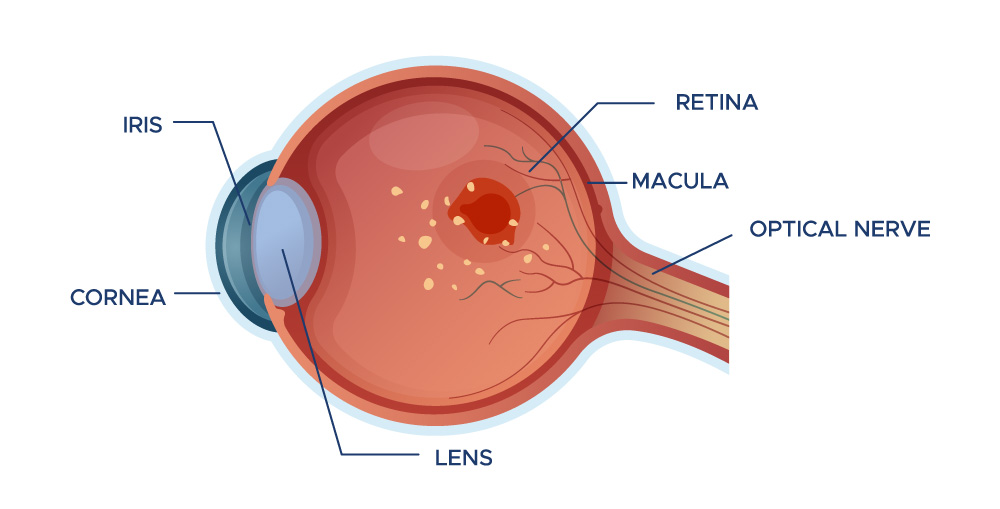Cornea, External Disease & Anterior Segment Care in Prescott
The cornea is the clear, front surface of your eye and the first structure light passes through on its way to the retina. Since the cornea provides nearly two-thirds of the eye’s focusing power, even small changes can significantly impact your vision. At our Prescott and Chino Valley eye care clinics, we specialize in diagnosing and treating corneal conditions with both medical and surgical options to help restore and protect your sight.
Understanding the Cornea: A Clear Window to the World

The human cornea has five layers in order, listed outermost to innermost:
5 Layers of The Cornea
- Corneal Epithelium – The cornea’s outermost region makes up approximately 10 percent of the tissue’s thickness.
- Bowman’s Layer – This sturdy layer of collagen protein fibers is beneath the membrane of the epithelium. If this layer is damaged, it can develop a scar when it heals. If the scar is towards the middle of the eye, it often causes some vision loss.
- Corneal Stroma –The stroma layer comprises 90 percent of the cornea’s tissue. The unique shape of this layer and lack of blood vessels produce the cornea’s transparency.
- Descemet’s Membrane – This layer is a thin piece of tissue. Its main function is to protect against injuries and infection. The Descemet’s membrane consists of collagen fibers.
- Corneal Endothelium – An extremely thin layer, this is the innermost layer of the cornea. These cells are necessary in order to keep the cornea transparent.
If any injury breaks through to a deeper layer of the cornea, the healing process takes longer and may result in the following symptoms: blurred vision, pain, redness, sensitivity to light and tearing. More serious injuries will produce corneal scarring, which can cause distorted vision or even dramatically impaired vision.
Common Corneal Conditions We Treat in Prescott
Dry Eye Syndrome
Many Prescott-area residents experience dry eye, often caused by the region’s dry climate. Symptoms may include:
-
Grittiness or burning
-
Blurred vision
-
Redness
-
Light sensitivity
Treatment depends on the cause and severity of your dry eye and may include prescription drops, in-office procedures, or advanced therapies.
Corneal Infections & Inflammation
Inflammation or infection of the cornea or conjunctiva (the clear membrane covering the eye) can cause:
-
Redness and pain
-
Blurred or reduced vision
-
Light sensitivity
Infections may be viral, bacterial, fungal, or protozoan, and require urgent care to avoid vision loss. Risk factors include contact lens wear and eye trauma. Prompt treatment can prevent permanent scarring.
Fuchs’ Dystrophy
Fuchs’ dystrophy is a genetic, progressive disease that damages the inner layer of the cornea (endothelium), leading to:
-
Blurred vision, especially in the morning
-
Halos or glare
-
Corneal swelling
Early treatment may include saline eye drops. In advanced stages, endothelial keratoplasty (partial corneal transplant) can restore vision with faster recovery and better outcomes than full transplants.
Keratoconus
Keratoconus is a common corneal condition in which the cornea begins to thin. As it thins, it loses strength, and aspects of the cornea start to bulge. The cornea changes into an abnormal shape, and one’s vision becomes affected. Initially, the vision can be corrected with glasses or contact lenses. As the disease progresses, there is loss of vision and corrective lenses may no longer be effective. It is recommended that patients with progressive keratoconus undergo early crosslinking treatment of the cornea to prevent the progression of their disease and permanent vision loss. This treatment is performed in the office and is the only FDA-approved treatment to halt the progression of keratoconus. Patients with severe untreated Keratoconus may need to undergo a full-thickness corneal transplant to restore good vision.
Corneal Transplants
For patients with severe corneal disease or endothelial damage, we offer advanced corneal transplant procedures in Prescott, including:
-
DMEK (Descemet’s Membrane Endothelial Keratoplasty)
- DSAEK (Descemet’s Stripping Automated Endothelial Keratoplasty)
These procedures involve transplanting only the affected corneal layers, resulting in:
-
Faster recovery
-
Improved vision
-
Lower rejection risk compared to full-thickness transplants
Learn More about Corneal Transplants
Your Prescott Cornea Care Experts
If symptoms of corneal diseases are making you uncomfortable and interfering with your daily life, give us a call us or schedule online. Our doctors have the expertise and tools to give you the relief you need.

